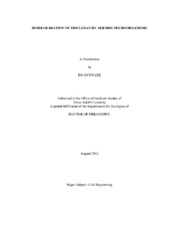| dc.description.abstract | Triclosan, a synthetic antimicrobial agent, is an emerging environmental contaminant. Due to incomplete removal of triclosan by wastewater treatment plants, treated wastewater is one major source of environmental triclosan. Biodegradation of triclosan has been observed in activated sludge and the environment, suggesting that it is possible to develop a cost-effective biotreatment strategy for triclosan removal from wastewater. However, current knowledge on triclosan biodegradation is scarce and limited. To bridge this knowledge gap, this dissertation characterized cultivable triclosan-degrading microorganisms, identified uncultivable triclosan-utilizing bacteria, and elucidated triclosan biodegradation pathways. Furthermore, two treatment strategies were examined to enhance triclosan biodegradation in nitrifying activated sludge (NAS).
A wastewater bacterial isolate, Sphingopyxis strain KCY1 (hereafter referred as strain KCY1), can completely degrade triclosan with a stoichiometric release of chloride. This strain can retain its degradation ability toward triclosan when after grown in complex nutrient medium containing triclosan as low as 5 micrograms/L. Based on five identified metabolites, a meta-cleavage pathway was proposed for triclosan biodegradation by strain KCY1. By using [13C12]-triclosan stable isotope probing, eleven uncultured triclosan-utilizing bacteria in a triclosan-degrading microbial consortium were identified. These clones are distributed among alpha-, beta-, or gamma-Proteobacteria, suggesting that triclosan-utilizing bacteria are phylogenetically diverse. None of these clone sequences were similar to known triclosan degraders.
Growth substrates affected the triclosan degradation potential of four selected oxygenase-expressing bacteria. Biphenyl-grown Burkholderia xenovorans LB400 and propane-grown Rhodococcus ruber ENV425 cannot degrade triclosan. On the other hand, propane- and 2-propanol-grown Mycobacterium vaccae JOB5 can degrade triclosan completely. Due to product toxicity, finite transformation capacities for triclosan were observed for Rhodococcus jostii RHA1 grown on biphenyl, propane, and LB medium with dicyclopropylketone (alkane monooxygenase inducer). Four chlorinated metabolites were detected during triclosan degradation by biphenyl-grown RHA1 and a meta-cleavage pathway was proposed.
Complete triclosan (5 mg/L) degradation was observed within 96 hrs in NAS receiving ammonia amendment (0 to 75 mg/L of NH4-N). The fastest triclosan degradation was observed in the NAS exhibiting the highest amount of ammonia. When ammonia oxidation was active in NAS, the amendment of strain KCY1 did not further enhance triclosan removal. Overall, the results suggested that triclosan biodegradation can be enhanced by increasing the activity of ammonia oxidation in NAS. | en |


